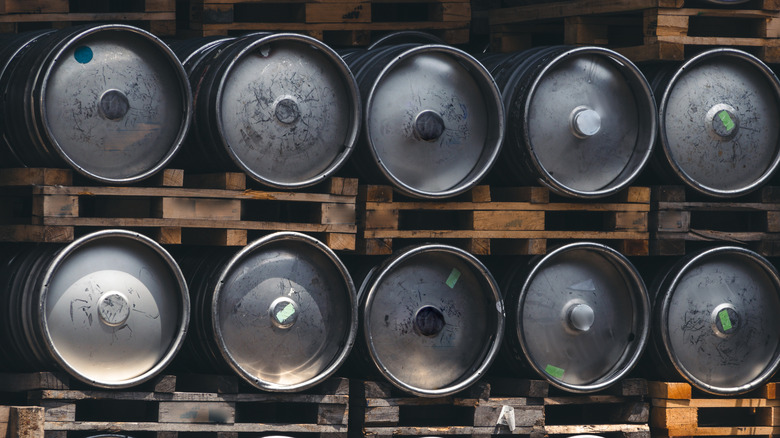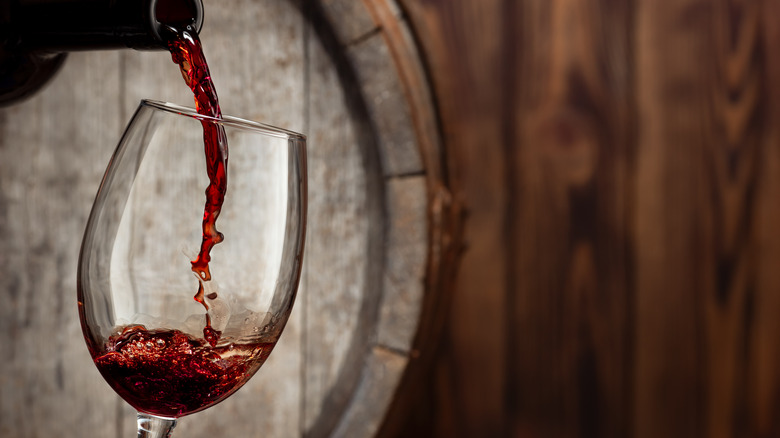What's The Difference Between Oak And Steel Barrel Aged Wine?
We may receive a commission on purchases made from links.
It makes sense why we say something "ages like a fine wine." Just like George Clooney, wine notoriously gets better with age. Most wines get more complex, more developed, more dimensional, and more enjoyable as time goes on. But before our favorite wine even makes it to the pretty bottles that fill our wine cellars and scatter our tabletops, there's an important stage that happens between fermenting and bottling. It's a process called élevage, per MasterClass, which is French for "raising" or "upbringing," and it can take anywhere from a few months to several years.
Wine needs somewhere to call home while it matures and develops and becomes the best it can be. So, where does it live all that time before we happily discover it at our favorite wine shop? While wine's home can come in many forms, from a concrete "egg" to a clay jar, the most traditional aging vessels are various types of wine barrels, including oak and stainless steel. "These variations can have profoundly different effects on the finished product," says Wine Enthusiast.
So, what exactly is the difference between oak and stainless steel barrel aging, and why does it matter?
Key differences between oak and stainless steel barrels
According to MasterClass, oak barrels are made of either American or European oak, toasted over a fire to a light, medium, or dark level. They require a longer aging process for the wine to benefit from the flavors and aromas of the wood, and they can only be used a few times before they become "neutral" and need to be replaced. Meanwhile, stainless steel barrels age the wine faster, are easier to clean, and can be used indefinitely, which is why steel barrel aged wine is generally less expensive than oak barrel aged wine.
As Wine Enthusiast explains, oak barrels come in a variety of shapes and sizes, all of which affect the wine's contact with the wood or the amount of oxygen inside. Stainless steel barrels are more straightforward; as MasterClass puts it, a stainless steel barrel "merely holds the wine for a few months while it stabilizes and the flavors integrate."
The material of the barrels is a very intentional choice by the winemaker. The main differences lie in the amount of oxygen, tannins, and flavor that the barrels provide for the wine. It comes down to how the grapes respond to the barrel and what type of final product is desired.
Differences in the final product
"Oak barrels do three things to wine," explains Wine Enthusiast. "They allow for oxygen exposure, which assists with maturation. They also provide tannins that give the wine structure. Finally, depending on the level of toast and age of the barrel, they also impart certain flavors."
Meanwhile, stainless steel barrels are pretty much the opposite — they don't expose the wine to any oxygen, they don't have an effect on tannins, and they don't impart any flavor to the wine. MasterClass says that "this kind of aging helps wines retain the fresh fruit aromas that degrade with exposure to oxygen."
Oak barrel aging is used to add more texture and an oaky flavor to grapes that benefit well from that type of maturation. For example, it can give more complexity to a neutral, aroma-less grape, such as chardonnay. Or, it can add notes of vanilla, caramel, or smoke to a grape such as cabernet sauvignon, which can withstand the oak's strong flavor. Stainless steel barrels, more common for white wines, are used for grapes with no or low tannins that are already fruity or aromatic, such as sauvignon blanc or grenache — something with a flavor the winemaker doesn't want to mask or obscure with oak.


